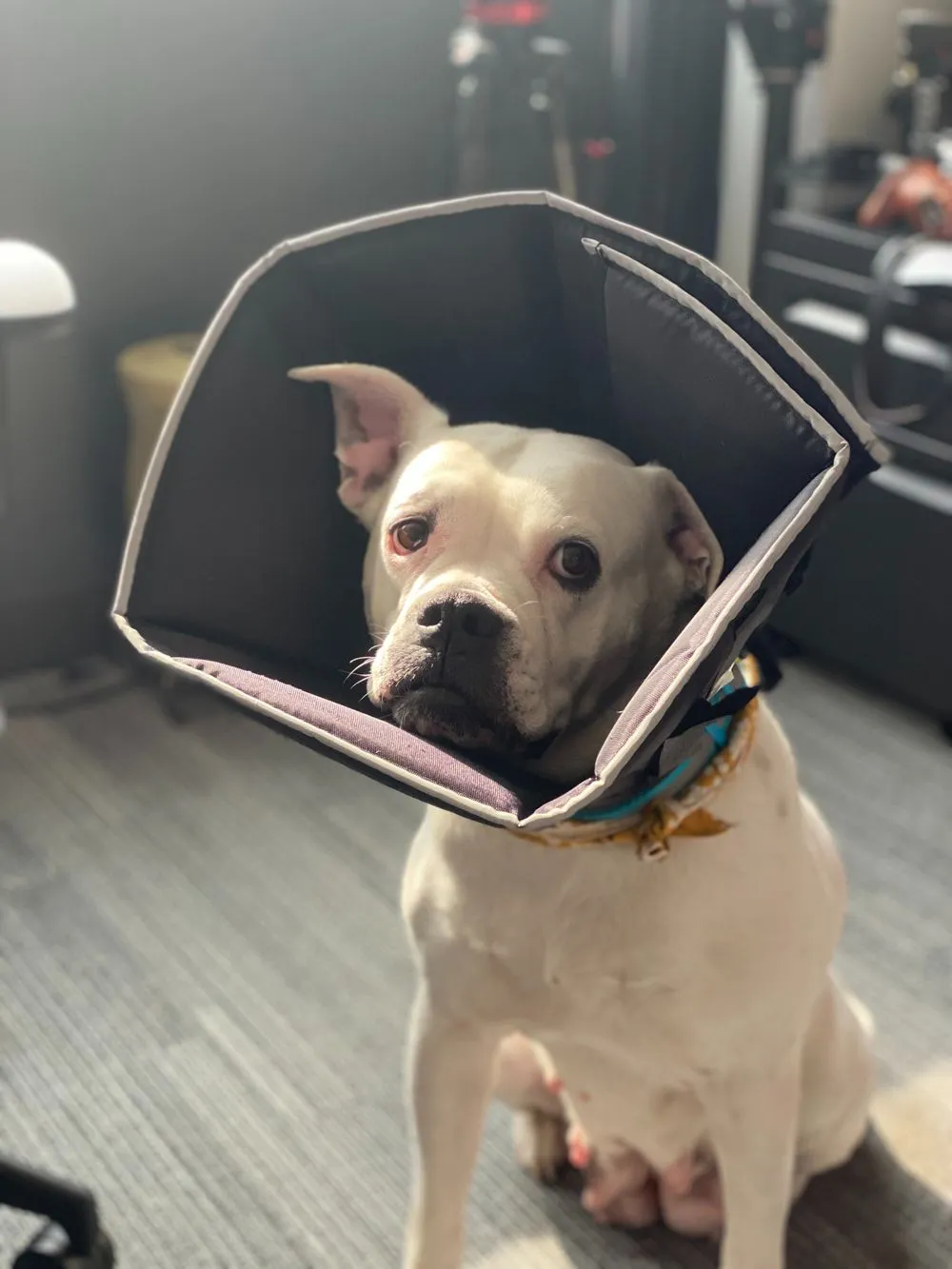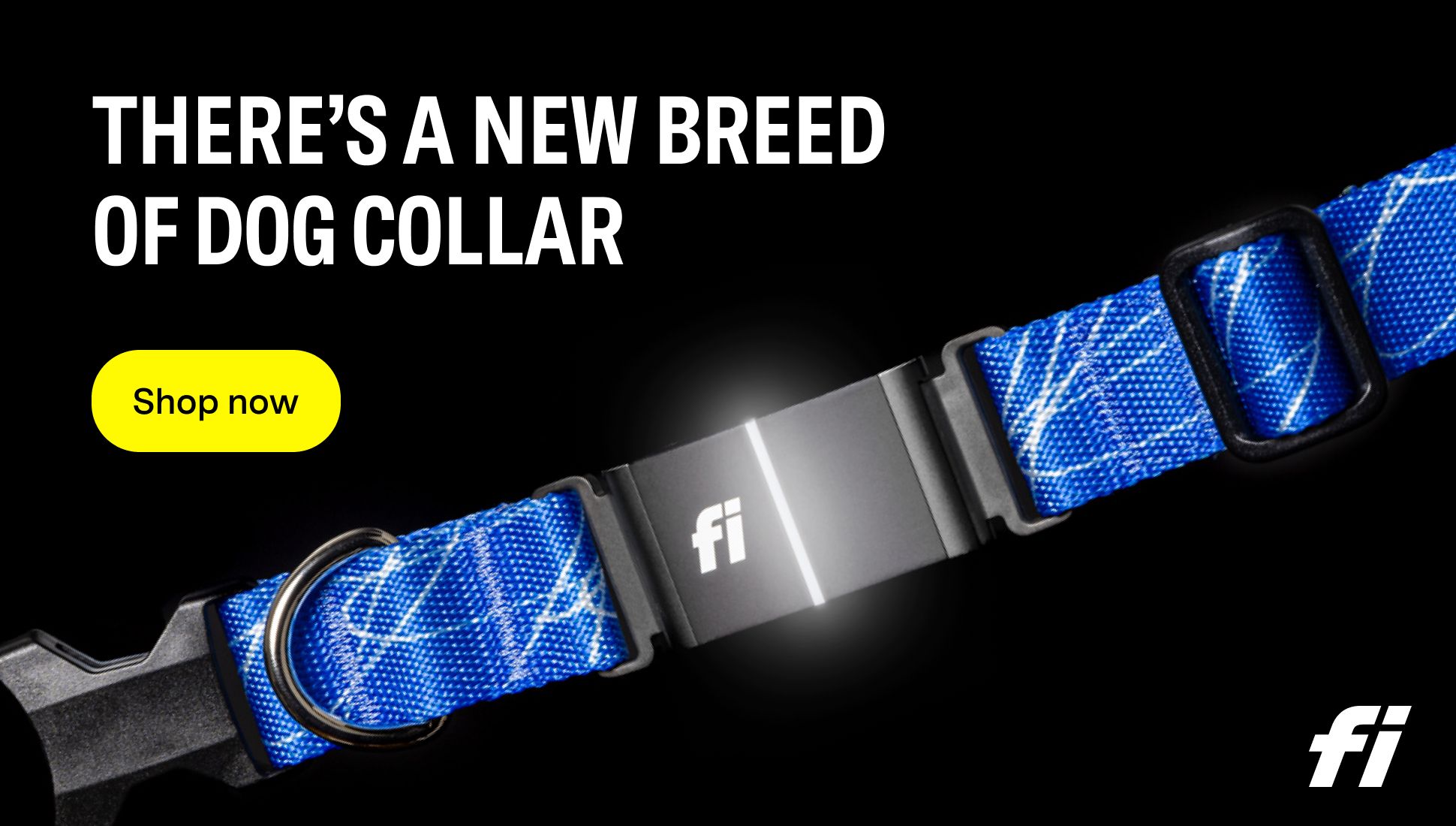An E-collar, also known as an Elizabethan collar or a cone, is commonly used to prevent dogs from licking or biting their wounds or surgical incisions. While the E-collar is essential for the dog's recovery and well-being, there comes a time when it becomes necessary to remove it. It is crucial to approach the process of E-collar removal with caution and care to ensure the dog's comfort and safety. Here is a step-by-step guide on how to properly remove the E-collar from a dog:

1. Why is an E-collar used for Dogs?
The E-collar is used to prevent dogs from licking, chewing, or scratching wounds, incisions, or irritations. It prevents them from causing further damage to the affected area, allowing it to heal properly.
2. When is it Safe to Remove the E-collar?
The timing for E-collar removal depends on the specific condition and the veterinarian's instructions. Typically, it is safe to remove the E-collar once the wound has healed sufficiently, and there is no longer a risk of the dog interfering with the recovery process.
3. Steps to Properly Remove the E-collar from a Dog:
- Step 1: Prepare the Environment: Choose a calm and comfortable area where the dog feels relaxed.
- Step 2: Distract the Dog: Engage the dog in a positive and interactive activity to divert its attention.
- Step 3: Remove the E-collar Gradually: Gently and slowly remove the E-collar, ensuring not to startle or frighten the dog.
- Step 4: Monitor the Dog's Behavior: Observe the dog for any signs of discomfort or excessive licking, and be ready to reapply the E-collar if necessary.
4. What to Do if the Dog Exhibits Negative Behavior after E-collar Removal?
If the dog starts excessively licking or biting the affected area after E-collar removal, it may be necessary to reintroduce the E-collar or seek guidance from a veterinarian to explore alternative solutions.
5. Tips for Successful E-collar Removal:
- Tip 1: Use Positive Reinforcement: Reward the dog with treats, praise, or favorite activities during and after E-collar removal.
- Tip 2: Gradually Increase Supervised Freedom: Allow the dog supervised access to limited areas to assess its behavior and ensure it doesn't aggravate the wound.
- Tip 3: Monitor the Healing Progress: Regularly check the wound for signs of infection or complications as the dog transitions to E-collar-free recovery.
6. Common Mistakes to Avoid when Removing the E-collar:
To ensure a smooth and successful transition after E-collar removal, it is important to avoid common mistakes like removing the collar too early, not monitoring the dog's behavior, or neglecting to provide alternative solutions to prevent licking or biting.
By following these guidelines and considering the specific needs of your dog, you can safely and properly remove the E-collar, facilitating a more comfortable and effective recovery process.
Why is an E-collar used for Dogs?
An E-collar for dogs is used for various purposes and offers several benefits. There are several reasons why an E-collar is used for dogs:
- Post-surgery recovery: An E-collar is used to prevent dogs from licking or biting at surgical incisions. By protecting the area, the collar reduces the risk of infection and promotes faster healing.
- Wound protection: Dogs can develop wounds from injuries, allergies, or skin conditions. Using an E-collar prevents them from scratching or biting the wounds, which helps prevent further damage and aids in the healing process.
- Behavior modification: E-collars can also be used as a training tool to correct certain behaviors. For instance, they can discourage excessive barking, furniture chewing, or other destructive behaviors. The collar provides a gentle deterrent to redirect their attention and establish better habits.
- Preventing self-harm: Some dogs tend to excessively scratch or chew themselves, which can lead to self-inflicted injuries. By wearing an E-collar, these dogs are unable to reach their bodies, minimizing the risk of self-harm and allowing existing wounds to heal.
- Protection after grooming: Dogs that have recently been groomed may be prone to scratching or biting at their newly trimmed fur. An E-collar prevents them from undoing the groomer's work and maintains their appearance until the fur grows out evenly.
It's important to note that the use of E-collars should always be done under the guidance of a veterinarian or professional dog trainer. These experts can determine the appropriate size and fit of the collar and ensure its safe and effective use based on the specific needs of the dog. By understanding why E-collars are used for dogs, pet owners can make informed decisions about the well-being and health of their furry companions.

When is it Safe to Remove the E-collar?
When considering the timing for safe removal of the e-collar from a dog, it is crucial to adhere to the guidance of the veterinarian who prescribed it and take into account the dog's individual healing progress. The e-collar plays a vital role in preventing the dog from interfering with the healing process and causing any additional harm or infection.
There are multiple factors to take into consideration prior to removing the e-collar. The incision site should be completely healed and devoid of any indications of redness, swelling, or discharge. The veterinarian will evaluate the incision during follow-up appointments to assess the progress of the healing process. Additionally, the dog should no longer exhibit any signs of discomfort or pain in the respective area. Another vital aspect to consider is the behavior of the dog.
If the dog is still scratching, licking, or biting at the incision site, it is not yet safe to remove the e-collar. This behavior may indicate that the wound has not fully healed and removing the e-collar could potentially result in further complications. It is of utmost importance to adhere to the veterinarian's instructions regarding the duration of e-collar usage. They will take into account factors such as the type of surgery performed, the breed and size of the dog, as well as any potential risk factors that could impact the healing process.
Premature removal of the e-collar could lead to the dog causing damage to the surgical site. The e-collar can be safely removed from a dog once the incision has fully healed, there are no indications of infection or discomfort, and the dog is no longer engaging in behavior that could disrupt the healing process. It is always recommended to consult with the veterinarian for guidance and diligently follow their instructions to ensure the dog's proper recovery.
Steps to Properly Remove the E-collar from a Dog
When it comes to removing the e-collar from your dog, there are essential steps you need to follow for a smooth and safe transition. In this section, we'll explore these steps and tips to ensure that you properly remove the e-collar without causing any discomfort or setbacks for your furry friend. From preparing the environment to monitoring the healing progress, we'll guide you through each step, making sure your dog adjusts well and continues on the path to recovery.
Step 1: Prepare the Environment
To properly remove the E-collar from a dog, it is important to follow the steps below. First, prepare the environment by ensuring that the surroundings are safe and free of any potential hazards that could harm the dog. Take the time to remove sharp objects and hazardous materials from the area to prevent accidents.
Approach the dog calmly and gently when removing the E-collar. This will help avoid causing any anxiety or fear. Speak to the dog in a soothing tone to keep them relaxed throughout the process.
If needed, secure the dog by gently holding onto their collar or using a leash. This will prevent them from running away or making sudden movements while removing the E-collar.
When removing the E-collar, do so gradually and carefully. Make sure it does not catch on the dog's fur or skin. Start by loosening the straps and smoothly slide the collar off. Take great care to avoid causing any discomfort or distress to the dog.
After removing the E-collar, closely monitor the dog's behavior. Look for any signs of discomfort, irritation, or scratching in the previously affected area. If any negative behavior or symptoms arise, it is important to consult a veterinarian for further guidance.
By following these steps, you can ensure a safe and stress-free experience when removing the E-collar from a dog. Remember to proceed with caution and prioritize the well-being and comfort of the dog throughout the entire process.
Step 2: Distract the Dog
During the process of removing the E-collar from a dog, it involves using treats or toys to keep their attention and make the removal easier and less stressful. Here are the steps to follow:
- Prepare treats or toys: Before attempting to remove the E-collar, gather some treats or toys that your dog finds appealing. This will help keep their attention and distract them from the removal process.
- Offer positive reinforcement: Utilize positive reinforcement techniques to redirect your dog's focus. Reward them with treats, praise, or play whenever they stay calm and cooperative during the removal process.
- Engage in play: Play with your dog using their favorite toy to keep them occupied and distracted. This will help reduce any anxiety or discomfort they may feel during the removal of the E-collar.
- Provide verbal reassurance: Use a calm and soothing tone of voice to reassure your dog throughout the process. Speak gently and give them verbal praise to keep them relaxed and distracted.
- Involve a second person (if necessary): If your dog is particularly anxious or resistant to collar removal, it may be helpful to have an extra pair of hands. The second person can provide additional distraction and support, making the process smoother.
By following these steps, you can effectively distract your dog during the E-collar removal process, ensuring a more comfortable experience for them. Remember to always monitor their behavior and proceed with caution to avoid any negative reactions or stress.

Step 3: Remove the E-collar Gradually
When it comes to removing the e-collar from a dog, it is important to do so gradually to ensure the dog's safety and comfort. Here are the steps to remove the e-collar gradually:
Step 1: Prepare the Environment
Before removing the e-collar, make sure the environment is safe and free from any potential hazards that could harm the dog. Remove any sharp objects or obstacles that may cause injury.
Step 2: Distract the Dog
- Distract the dog with treats or toys to keep its attention away from the e-collar. This will help keep the dog calm and make the removal process easier.
Step 3: Remove the E-collar Gradually
Gently loosen the e-collar or adjust the size to make it more comfortable for the dog. Gradually remove the e-collar by releasing the Velcro straps or unclipping the buckles. Take it off slowly and ensure the dog remains calm throughout the process.
Step 4: Monitor the Dog's Behavior
Observe the dog's behavior after removing the e-collar. Pay attention to any signs of discomfort, scratching, or excessive licking in the area where the e-collar was worn. If any negative behavior is observed, consult a veterinarian for further advice.
By following these steps, you can safely and gradually remove the e-collar from your dog, ensuring their comfort and well-being.
Step 4: Monitor the Dog's Behavior
To monitor the dog's behavior after removing the E-collar, follow these steps:
- Observe the dog closely for any signs of discomfort or distress. Watch for excessive scratching, licking, or biting at the incision site or any unusual behavior.
- Check for any signs of swelling or redness around the wound. If you notice any abnormal changes in the appearance of the incision, it may indicate an infection or complication.
- Keep an eye on the dog's activity level. If the dog becomes overly energetic or starts engaging in rough play, it could potentially reopen the wound or cause further injury.
- Monitor the dog's eating and drinking habits. A loss of appetite or changes in water intake may indicate pain or discomfort.
- Step 4: Monitor the Dog's BehaviorTake note of the dog's demeanor and overall mood. If they seem depressed, anxious, or unusually aggressive, it could be a sign that they are experiencing discomfort or distress.
It is important to remember that every dog is different, and their recovery process may vary. Wound healing can take time, and it is crucial to provide proper care and attention during this period. If you notice any concerning behavior or have any doubts about the dog's well-being, contact your veterinarian for further guidance and advice.
In history, the use of E-collars for dogs has evolved over time. Originally designed to prevent dogs from biting or scratching at incisions after surgery, E-collars have proven to be effective tools in aiding the healing process. It is essential to carefully monitor a dog's behavior after removing the E-collar to ensure optimal recovery.
Continuous observation allows pet owners to address any potential issues promptly and provide the necessary care for their furry companions' well-being.

What to Do if the Dog Exhibits Negative Behavior after E-collar Removal?
What to Do if the Dog Exhibits Negative Behavior after E-collar Removal?
- Observe the behavior: Pay attention to any changes in your dog's behavior, such as increased anxiety, aggression, or fearfulness. Note the specific behaviors that are concerning.
- Consult a professional: Reach out to a professional dog trainer or behaviorist for guidance. They can assess the situation and provide tailored advice to address the specific negative behaviors your dog is exhibiting.
- Create a positive environment: Ensure that your dog is in a calm and safe environment. Eliminate any triggers that may be contributing to their negative behavior and provide plenty of mental and physical stimulation to keep them engaged.
- Train alternative behaviors: Use positive reinforcement training techniques to redirect your dog's negative behavior towards more desirable alternatives. Rewarding good behavior will encourage them to make positive choices.
- Seek additional support if needed: If your dog's negative behavior persists or worsens, consider seeking the help of a veterinary behaviorist. They have specialized knowledge and tools to address complex behavioral issues in dogs.
Remember, each dog is unique, and what works for one may not work for another. Patience, consistency, and positive reinforcement are key when helping your dog through this transition period. By following these steps, you can effectively address any negative behavior your dog may exhibit after e-collar removal and help them thrive in a positive and calm environment.
Tip 2: Gradually Increase Supervised Freedom
To gradually increase supervised freedom for a dog after removing the E-collar, follow these steps:
- Start in a controlled environment: Begin by allowing the dog some freedom in a small, confined space, such as a single room or a gated area. This will ensure that the dog is safe and cannot engage in any potentially harmful behavior.
- Gradually Increase Supervised Freedom: As the dog adjusts to the increased freedom, closely monitor their behavior and interactions. This will help you intervene if any issues arise or if the dog shows signs of discomfort or anxiety.
- Expand the space gradually: After a period of successful supervised freedom in a controlled environment, slowly increase the space the dog has access to. This can be done by opening up additional rooms or expanding the size of the gated area.
- Observe behavior and adjust: Continuously monitor the dog's behavior during the expanded supervised freedom. If you notice any negative behavior or signs of stress, reduce the space temporarily and gradually reintroduce the larger area once the dog is more comfortable.
Fact: Gradually increasing supervised freedom after removing the E-collar allows the dog to regain their confidence and adjust to being without the collar. It provides a balanced approach that ensures the dog's safety while promoting their well-being and gradual reintegration into their normal activities.

Tip 3: Monitor the Healing Progress
- Monitor the healing progress of your dog after the removal of an e-collar is crucial for their well-being. Here are some steps to effectively monitor their healing progress:
- Observe the Incision Area: Take a close look at the incision area to ensure it is healing properly. Look for any signs of redness, swelling, discharge, or unusual odor.
- Check for any Abnormal Behavior: Monitor your dog's behavior closely. If they are constantly licking or scratching the incision area excessively, it may indicate discomfort or infection. This behavior should be addressed promptly.
- Tip 3: Monitor the Healing Progress: Assess the pace at which the wound is healing. Notice any changes in the size, appearance, or color of the incision. A healthy healing process involves gradual closure and fading of the incision.
- Keep the Area Clean: Follow the veterinarian's guidelines for keeping the incision area clean and sterile. Regularly clean the area with mild antiseptic solutions and keep it dry to prevent infection.
- Note Any Unusual Symptoms: Stay vigilant for any unusual symptoms such as fever, loss of appetite, lethargy, or any signs of pain. These could indicate complications and require immediate veterinary attention.
- Ensuring proper healing progress is essential to prevent complications and promote a speedy recovery for your dog. Remember to consult your veterinarian if you notice anything concerning during the monitoring process.
- To successfully monitor the healing progress of your dog after e-collar removal, follow these additional suggestions:
- Keep a healing progress journal to note down any changes or observations.
- Take pictures of the incision area regularly to document the healing process visually.
- Stay in regular communication with your veterinarian and seek their guidance if you have any concerns.
- By actively monitoring the healing progress and promptly addressing any issues, you can ensure your dog's recovery is on track and intervene if necessary.
Common Mistakes to Avoid when Removing the E-collar
When removing the e-collar from your dog, it is important to avoid common mistakes to ensure the safety and comfort of your furry friend. Here are some key tips to follow when taking off the e-collar:
- Rushing the process: Take your time and be patient when removing the e-collar. Abruptly removing it can startle your dog and cause anxiety or stress.
- Not checking for any wounds or injuries: Before taking off the e-collar, carefully inspect your dog's skin for any wounds or injuries. If you find any, consult with your veterinarian first to prevent further harm or infection.
- Removing it too soon: It is crucial to keep the e-collar on for the recommended duration as advised by your veterinarian. Removing it prematurely can interfere with the healing process and increase the risk of your dog licking or biting the affected area.
- Forgetting to distract your dog: During the collar removal, it is helpful to distract your dog with treats or toys. This will prevent them from focusing on the removal process, making it a more positive experience and reducing any potential resistance or fear.
- Improperly disposing of the e-collar: Once you have removed the e-collar, make sure to dispose of it properly in a safe and environmentally-friendly manner. This will prevent accidents and ensure the collar does not end up in the wrong hands.
Always consult with your veterinarian for specific instructions on safely removing the e-collar from your dog. By avoiding these common mistakes, you can ensure a smooth and stress-free collar removal process for your beloved pet.
Frequently Asked Questions
How can I remove the E-collar from my dog?
To remove the E-collar, follow these step-by-step instructions:
- Prepare a calm environment where you and your dog can relax.
- Gather the necessary supplies, including scissors with rounded tips and treats.
- Assess your dog's mood and ensure they are relaxed and receptive.
- Approach your dog slowly and calmly, offering soothing words and gentle strokes.
- Lift the E-collar away from your dog's neck while supporting their neck with one hand.
- Use the rounded-tip scissors to carefully cut the fasteners or clips securing the E-collar.
- Gradually slide the E-collar away from your dog's neck, taking breaks if needed.
- Celebrate and reward your dog with treats and affection once the E-collar is successfully removed.
Are there any alternatives to the E-collar?
Yes, there are alternative options available in the market. You can refer to a comparison chart of popular alternatives to find one that suits your dog's needs.
Why is the E-collar important for my dog?
The E-collar, also known as the Cone of Shame or Lamp Shade, is important to prevent dogs from biting or licking their incision after surgery. If a dog accesses the incision, it can lead to infection or damage, which can be harmful and costly for the dog.
Can I remove the E-collar if my dog hates it?
While some dogs tolerate the E-collar well, others may try to remove it. It is generally recommended to keep the E-collar on for 7-10 days after surgery to allow for proper healing. However, if your dog dislikes the collar, there are alternative options available that you can consider.
Is it safe for my dog to sleep with the E-collar on?
Yes, dogs can sleep with their cone on if necessary. The E-collar is designed to provide freedom of movement while still preventing the dogs from accessing their incision.
Who invented the E-collar and why is it called the "Cone of Shame" or "Lamp Shade"?
The E-collar was invented and patented by F.L. Johnson in 1962. However, it is unclear if Johnson was a veterinarian. The collar was named after Queen Elizabeth the First, who wore a ruff collar of lace in the 16th century. The nicknames "Cone of Shame" or "Lamp Shade" likely stem from the perceived embarrassment that dogs may feel when wearing the collar.

